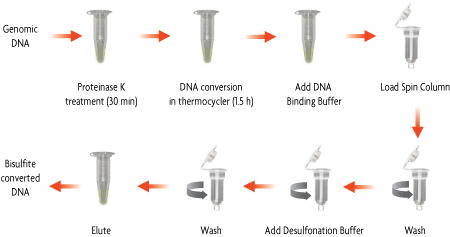Bisulfite Conversion Kit
Bisulfite-Conversion-Kit-AM176
Synonyms
| Name | Format | Cat No. | Price | Delivery |
|---|
Overview
Active Motif's Bisulfite Conversion Kit simplifies the analysis of DNA methylation by providing optimized conversion reagents and an easy-to-use protocol. DNA of interest is rapidly heat denatured in a thermocycler in the presence of the bisulfite conversion reagent and a DNA denaturant. The conversion reaction can be performed in as little as 1.5 hours with a 99% conversion efficiency of unmethylated cytosines to uracils. After DNA conversion, the sample is added to the included DNA purification columns, and a simple, on-column desulfonation is performed. Ready-to-use DNA is then eluted from the columns. For your convenience, a positive control conversion-specific PCR primer pair that is specific for bisulfite converted human and mouse DNA is included. Because the primer pair produces a PCR product only if conversion has occurred, you can validate the success of the conversion reaction before spending extra time and money on sequencing.
Active Motif also offers it's original MethylDetector™ Bisulfite Modification Kit. This assay performs bisulfite conversion of DNA using the same principle as the Bisulfite Conversion Kit, but is optimized for use with a 5 hour conversion reaction.
Documents (6)
Data
Bisulfite Conversion
DNA methylation is an essential epigenetic modification that plays a key role in transcriptional regulation and assures the proper regulation of gene expression and stable gene silencing in normal cells. In methylation, a methyl group is added to the fifth-carbon of cytosine in a CpG dinucleotide by a DNA methyltransferase. As aberrant methylation is prevalent in many human cancers, and because methylation is also involved in embryonic development and cell cycle regulation, alterations in the methylation status of DNA can serve as promising indicators for disease diagnosis and prognosis.
The bisulfite conversion reaction was first described in the early 1970s to distinguish between cytosine and 5-methylcytosine (5-mC) in DNA1,2. It is now known that both 5-methylcytosine and 5-hydroxymethylcytosine (5-hmC) remain unchanged during conversion and, therefore, this method cannot be used to distinguish between the different methyl modifications. In the bisulfite conversion reaction, DNA is first treated with sodium bisulfite to convert cytosine residues into a cytosine-bisulfite derivative in denatured (single-stranded) DNA. This reaction is reversible, with the forward reaction being favored by high temperature and low pH. The second step is an irreversible hydrolytic deamination of the cytosine-bisulfite derivative that results in a uracil-bisulfite derivative. This reaction is also favored by low pH. The final step involves the desulfonation of the uracil-bisulfite derivative to uracil under high pH conditions. Only unmethylated cytosines are susceptible to the bisulfite reaction, therefore 5-mC and 5-hmC remain the unchanged. Following bisulfite conversion, the DNA is often amplified by PCR where the uracils are converted to thymines. A schematic of the bisulfite conversion reaction is shown below.

Schematic of the bisulfite conversion reaction of unmethylated cytosine to uracil.
Flow Chart of Active Motif's Bisulfite Conversion Kit
Active Motif's Bisulfite Conversion Kit simplifies the analysis of DNA methylation by providing optimized conversion reagents, an easy-to-use protocol and a positive control PCR primer set to validate results. The conversion reaction can be performed in as little as 1.5 hours with a 99% conversion efficiency. For your convenience, a conversion-specific PCR primer pair is included to validate the success of the bisulfite conversion before starting sequencing or other analysis methods. The positive control primer pair is specific for bisulfite-converted human and mouse DNA and will only produce a 220 bp PCR product if the conversion reaction was successful (Figure 2).
Figure 1: Flow Chart of the Bisulfite Conversion Kit.
In the Bisulfite Conversion Kit, genomic DNA of interest is proteinase K treated, then rapidly heat denatured in a thermocycler in the presence of the bisulfite conversion reagent and DNA denaturant. Following a 1.5 hour DNA conversion reaction, the sample is added to the included DNA purification columns and a simple on-column desulfonation is performed. DNA is then eluted from the column and is ready for use in PCR or other downstream applications.

Figure 2: Positive control conversion-specific PCR primer pair is specific for converted human and mouse DNA.
PCR results of human (A) and mouse (B) genomic DNA that was either bisulfite converted (Bis.) according to the Bisulfite Conversion Kit assay protocol or untreated (Untr.), then amplified using the included positive control conversion-specific PCR primer pair. The primer pair is specific towards bisulfite converted DNA and, therefore, a 220 bp PCR amplicon is present in the bisulfite treated DNA samples and not the untreated DNA samples.
References
- Frommer, M. et al. (1992) PNAS. 89: 1827.
- Clark, S.J. et al. (1994) Nuc. Acids Res. 22: 2990-2997.
Contents
Contents & Storage
The Bisulfite Conversion Kit is shipped at room temperature and can be stored at 4°C prior to first use. Then, we recommend storing each component at the temperatures listed in the table below. Components are guaranteed stable for 6 months from the date of receipt when stored properly. This Bisulfite Conversion Kit includes the following components:
- Conversion Reagent (5 tubes, lyophilized); Store at RT
- Denaturation Reagent; Store at RT
- Hydroquinone (5 tubes); Store at RT
- Buffer A; Store at RT
- Buffer B; Store at RT
- DNA Binding Buffer (2 bottles); Store at RT
- DNA Wash Buffer; Store at RT
- DNA Elution Buffer; Store at RT
- DNA purification columns and collection tubes (50 each); Store at RT
- Proteinase K (2 mg lyophilized); Store at -20°C
- Conversion-specific PCR primer pair (4 µM); Store at -20°C
Contents & Storage
The MethylDetector™ Kit is shipped at room temperature and can be stored at 4°C prior to first use. Then, we recommend storing each component at the temperatures listed in the table below. Components are guaranteed stable for 6 months from the date of receipt when stored properly. This MethylDetector™ Kit includes the following components:
- Conversion Reagent (5 tubes, lyophilized); Store at RT
- Denaturation Reagent; Store at RT
- Hydroquinone (5 tubes); Store at RT
- Buffer A; Store at RT
- Buffer B; Store at RT
- DNA Binding Buffer (2 bottles); Store at RT
- DNA Wash Buffer; Store at RT
- DNA Elution Buffer; Store at RT
- DNA purification columns and collection tubes (50 each); Store at RT
- PCR primers; Store at -20°C
- 10X PCR Buffer; Store at -20°C
References
MethylDetector™ Publications
The following list represents selected publications in which Active Motif's assay has been used:
- “Aberrant methylation of the PTCH1 gene promoter region in aberrant crypt foci.” by Peng L. et al. (2013) Int J Cancer, 132(2): E18-25.
- “Transcription intermediary factor 1γ is a tumor suppressor in mouse and human chronic myelomonocytic leukemia.” by Aucagne R. et al. (2011) J Clin Invest., 121(6): 2361-2370.
- “Ploidy and large-scale genomic instability consistently identify basal-like breast carcinomas with BRCA1/2 inactivation.” by Popova T. et al. (2012) Cancer Res., 72(21): 5454-5462.
- “miR-126 and miR-126* repress recruitment of mesenchymal stem cells and inflammatory monocytes to inhibit breast cancer metastasis.” by Zhang Y. et al. (2013) Nat Cell Biol., 15(3): 284-294.
- “Cerebellum-specific and age-dependent expression of an endogenous retrovirus with intact coding potential.” by Lee K.H. et al. (2011) Retrovirology, 8: 82.
- “Lsh/HELLS regulates self-renewal/proliferation of neural stem/progenitor cells.” by Han (2017) Scientific Reports 7(1):1136.

